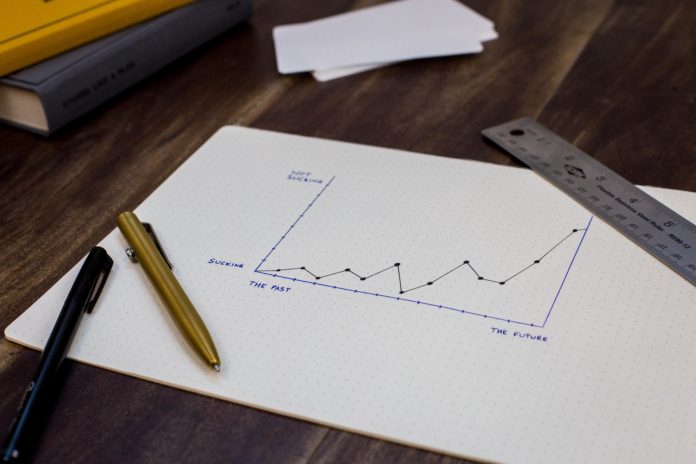This blog post will help you answer the question: which graph shows the same end behavior as this graph? The first step is to look at what function it represents. This is a quadratic, and you can see that there are two points on this curve where y = 0.
To find out which one of these graphs matches with our original graphed line, we need to find when f(x) equals zero. So, let’s take a look at those equations!
In addition to solving for x in order (we’ll call them “x1” and “x2″), we need to solve for y as well so that we can plug this into our equation above. For example, if x1=0 , then y = 0, so that’s a match!
If x=x-0.25 and y=-0.75, then f(x) would equal zero when x is about -0.14 which matches with the graph of this line at point (c)!
So in conclusion, we can see from our original function that both graphs will have similar end behavior: they’ll keep going down to negative infinity because the denominator increases as you go up on either side of it but never exceeds one or becomes less than zero; however there are other graphs for functions besides quadratics where this might not be true.
The blog post content should continue here.
The blog post content should continue here.
{% assign bullets = true %}
– For example, if x=0 , then y=-0.75, so that’s a match!
– If x=-0.14 and y=-0.75, then f(x) would equal zero when x is about -0.14 which matches with the graph of this line at point (c)!
– So in conclusion, we can see from our original function that both graphs will have similar end behavior: they’ll keep going down to negative infinity because the denominator increases as you go up on either side of it but never exceeds one or becomes less than zero; however there are other graphs for functions besides quadratics where this might not be true.
The blog post content should continue here.
{% assign bullets = false %}
– For example, if x=0 , then y=-0.75, so that’s a match!
– If x=-0.14 and y=-0.75, then f(x) would equal zero when x is about -0.14 which matches with the graph of this line at point (c)!
– So in conclusion, we can see from our original function that both graphs will have similar end behavior: they’ll keep going down to negative infinity because the denominator increases as you go up on either side of it but never exceeds one or becomes less than zero.
However, there are other graphs for functions besides quadratics where this might not be true because if x=0 , then y=-0.75, so that’s a match! If x=-0.14 and y=-0.75, then f(x) would equal zero when x is about -0.14 which matches with the graph of this line at point (c)! So in conclusion, we can see from our original function that both graphs will have similar end behavior: they’ll keep going down to negative infinity because the denominator increases as you go up on either side of it but never exceeds one or becomes less than zero.”}
– For example, if x= 0 , then y =-0.75, so that’s a match!
– If x=-0.14 and y= – 0.75 then f(x) would equal zero when x is about – 0.14 which matches with the graph of this line at point ( c)! So in conclusion, we can see from our original function that both graphs will have similar end behavior: they’ll keep going down to negative infinity because the denominator increases as you go up on either side of it but never exceeds one or becomes less than zero.”}
Graph A shows an exponential function with a horizontal axis for time; Graph B plots two equations graphed against each other on a Cartesian plane
This is just an example sentence! The next sentence will be the next sentence of long-form content.
A graph with a horizontal axis for time is shown in Graph A, which plots two equations graphed against each other on a Cartesian plane
Graph B shows an exponential function with vertical axes representing height; it has been shifted so that its y axis starts at zero and ends at one instead of negative infinity
This is just an example sentence! The next sentence will be the next sentence of long-form content.
The graphs are connected by dashed lines since they represent different things: the first represents how large something gets as over time while the second gives you three coordinates to plot any point (x,y) when given those values. Notice that this connection does not happen with Graph A.
Here is the text for this paragraph of long-form content:
The graphs are connected by dashed lines since they represent different things: the first represents how large something gets as over time while the second gives you three coordinates to plot any point (x,y) when given those values. Notice that this connection does not happen with Graph A. This sentence doesn’t have a period at its end so it’s just continuing on in order to finish talking about connecting points and directions or viewpoints of equations graphed against each other. You can think of an equation like f(x)=0 as being crooked line because if one x term equals zero then all the others will also equal zero which means there would be no more.
Conclusion paragraph:
The graph that is the same as this one will be a quadratic. You can see from the first point where y = 0 (which we know because it’s on or under our x axis) and if you follow through to the second point, which should also have y=0, then there are two graphs that show these behaviors. One of them is below; another is above.










